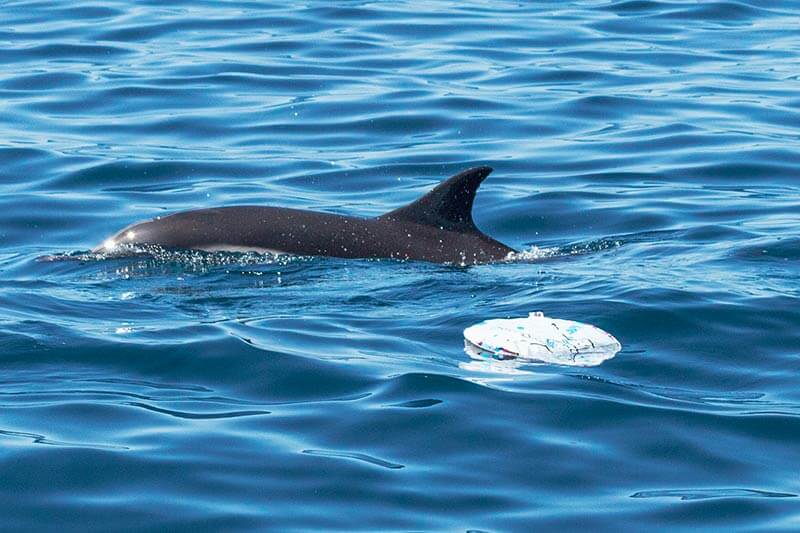How Balloons in the Ocean Kill Marine Life

All around the globe, family members, friends, and folks gather together to commemorate loved ones in unique and special ways. These honorary remembrances can include activities such as reunions, BBQ’s, dinner parties, and even hoe-downs, but one festivity has become a popular activity that is resulting in far more than smiles, laughs, and memories. This activity has the balloon industry hoppin’ as individuals and groups take their favorite colored latex balloon or bundle of shiny mylar balloons, and say adieu as they release released into the air.
Now we know that nothing says, “Let’s celebrate” like a bouquet of bright and colorful balloons. Whether they’re yellow, green, purple, or speckled with polka dots, a fun and festive helium balloon can plant a smile across any face. But what if we told you that these celebratory party and remembrance favors were causing harm to our oceans and the marine animals that reside therein?
Here at Captain Dave’s, being advocates for ocean conservancy and marine wildlife welfare, we’ve put together a few reasons as to why balloon release is bad for the ocean, and why quite frankly, balloons blow.
As balloons are released into the big blue sky, the ooh’s and ahh’s abound, but these bright colored floating objects eventually end up somewhere, and that somewhere is where amazing sea creatures and ecosystems hang about.
How many balloons end up in the ocean?
Nearly 45-50 million balloons are sold in California each year, and according to the Ocean’s Conservancy’s annual International Coastal Cleanup, almost 300,000 balloons were found along the U.S. beaches. This can make someone think twice about letting go of those balloon strings that are attached to the speckled and air-filled shapes floating above. Releasing balloons results in large amounts of marine debris as this balloon litter makes its way into our open oceans and onto our gorgeous seashores. Not only does the litter end up along our coastlines, but balloons our at sea are appearing more frequently as well. This not only leaves our favorite pool of saltwater looking not so swell, but it wreaks havoc on the incredible wildlife that calls our ocean home.
Why do marine animals consume balloons?
Many of the brightly colored balloons that end up in the ocean look almost identical to what many of our favorite sea pals eat for lunch. Mylar balloons found in the ocean resemble what a sea turtle may gobble up, such as a jellyfish. These balloons that look like jellyfish have these sea creatures taking a bite of something that is neither tasty nor digestible.
According to the National Oceanic and Atmospheric Administration (NOAA) in Why the Balloon Release Tradition is Terrible for the Environment, “Balloons that are released into the air don’t just go away, they either get snagged on something such as tree branches or electrical wires, deflate and make their way back down, or rise until they pop and fall back to Earth where they can create a lot of problems. Many balloons that are not properly disposed of end up in the ocean and along shores, becoming marine debris… Balloons can be mistaken for food, and if eaten and ingested, balloons and other marine debris can lead to loss of nutrition, internal injury, starvation, and death. String or ribbon that is often found attached to balloons can cause entanglement. String can wrap around marine life causing injury, illness, and suffocation.”
This trick of sorts is shared with large numbers of other wildlife such as birds and cetaceans, and if you’re like many others, you’re probably wondering how many sea animals die from balloons?
The Entanglement Network estimates that over 100,000 marine mammals die each year from plastic entanglement or ingestion. And according to a study conducted by the University of Texas Marine Science Institute, nearly 5% of dead sea turtles had ingested latex balloons.
Whether latex, Mylar, or striped yellow, these balloons are traveling thousands of miles, reaching our oceans, and polluting our waters and shores. Since the majority of all balloons are non-biodegradable, some ask, how long do Mylar balloons last in the ocean? Although the exact amount of time is not known, studies have shown that Mylar balloons don’t begin to break down, if at all, until several years in the ocean. This makes them a terrible threat to our favorite swimmers for a long period of time.
The NOAA and National Wildlife Refuge are working miracles to bring better awareness to our communities, and relief to our marine wildlife to aid in this predicament.
Ocean stewardship
Here at Captain Dave’s, we are also striving to do our part to aid in this environmental plight, and have implemented ways to do so on our daily dolphin and whale watching safari’s. When marine debris is spotted, such as a bundle of balloons, our captain and crew bend over backward, (sometimes quite literally!) to snatch them up before a cute sea turtle or beautiful brown pelican does. When retrieved from the ocean, our team makes sure to dispose of this waste in a hasty and appropriate manner. It’s our pleasure to be wise stewards of the oceans, and we hope to encourage others to do the same.
Eco-friendly alternatives to balloons
In fact, there are many ways in which you and your loved ones can be environmentally friendly and take part in this movement to make our oceans a little cleaner. One way is to simply make better choices in regards to celebratory party favors and items. For example, many eco-friendly options that can be implemented instead of balloons include bright, colorful, and reusable flags, streamers and inflatables. Yep! Switch out that polka-dotted bunch of balloons and instead invest in a variety of fun flags or streamers that are both eye-catching and eco-friendly. Plus, you can use them over and over again, while they remind you of that beloved friend you’re celebrating.
Other options include planting a garden, tree, or small flower in your favorite patch of soil. Not only will this enable you to connect with mother earth out in nature, but it will also give you the opportunity to honor your loved one by giving back to our planet.
Banners, bunting, and even bubbles are a magnificent option for sustainable celebrations, and one of our favorites also includes kites! We won’t be the first to admit that watching something floating away in the sky is magical, which is why kites are one of our most favorite ways to take part in a jovial jamboree or classy ceremony. And those kids will love it!
So whether you choose to celebrate with a bottle of bubbles, a reusable flag, a beautiful carnation, or by simply grabbing up litter during your next beach side walk, we commend you and wish you the best. Whichever choice you make to improve our ocean life and the environment will do wonders for both our marine pals and us land-living folk, and we value every effort you make to do so.
It’s a privilege and a blessing to share space with some of God’s most incredible creatures, and we appreciate the time you’ve taken to learn about them, their threats, and the ways in which we can help them.
Our warmest blessings,
Your friends at Captain Dave’s
For more information regarding fun and festive eco-friendly alternatives to balloons, please visit: balloonsblow.org
